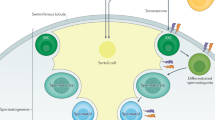Abstract
Pubertal development and androgen production were evaluated 1–10 years after bone marrow transplantation (BMT) in 15 females aged 14–23 (mean 17) years. Before BMT, these patients had received combination chemotherapy for hematologic malignancy, and all had had a transplant program including total body irradiation (TBI). Of the nine patients who were pre-menarcheal at BMT, two had subsequently experienced spontaneous menarche at 11.5 and 13.3 years of age. Six were post-menarcheal, but became amenorrheic after BMT. Menstruation subsequently started spontaneously in one of them 6 years after BMT. At the time of the study, three patients were early to mid-pubertal and 12 late pubertal or post-pubertal. Twelve patients were receiving sex steroid substitution therapy. Serum concentrations of testosterone, androstenedione, dehydroepiandrosterone (DHEA) and DHEA sulfate (DHEAS) were determined. Androgen levels of late pubertal and post-pubertal transplanted patients were compared with 19 post-menarcheal patients aged 14–21 (mean 17) years who had been treated for hematologic malignancy with conventional chemotherapy. Testosterone levels of 52 healthy post-menarcheal females aged 14–29 (mean 19) years were measured as controls. Androgen levels of the BMT patients were lower than those of the conventionally treated patients. Differences in testosterone, androstenedione and DHEA levels were significant. Three spontaneously menstruating BMT patients had normal androgen levels. Testosterone levels of the conventionally treated patients and healthy controls were similar. Subnormal androgen production might be one factor behind the problems in pubertal development and sex life experienced by females after BMT. The use of these hormone levels for follow-up purposes and the potential value of androgen replacement therapy in females after TBI merit further study.
This is a preview of subscription content, access via your institution
Access options
Subscribe to this journal
Receive 12 print issues and online access
$259.00 per year
only $21.58 per issue
Buy this article
- Purchase on Springer Link
- Instant access to full article PDF
Prices may be subject to local taxes which are calculated during checkout
Similar content being viewed by others
Author information
Authors and Affiliations
Rights and permissions
About this article
Cite this article
Hovi, L., Tapanainen, P., Saarinen-Pihkala, U. et al. Impaired androgen production in female adolescents and young adults after total body irradiation prior to BMT in childhood. Bone Marrow Transplant 20, 561–565 (1997). https://doi.org/10.1038/sj.bmt.1700927
Received:
Accepted:
Issue Date:
DOI: https://doi.org/10.1038/sj.bmt.1700927



